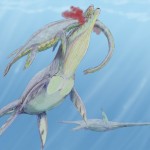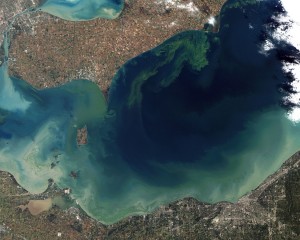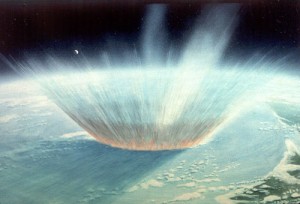4 December 2015
Dinosaur-killing asteroid may have caused global algal bloom, marine extinction
Posted by lhwang
By Lillian Steenblik Hwang
The asteroid impact suspected of killing the dinosaurs may also have triggered a global algal bloom that contributed to a massive marine extinction more than 60 million years ago, according to a new study published in the Journal of Geophysical Research: Planets, a publication of the American Geophysical Union.
Around 66 million years ago, an asteroid 10 kilometers (six miles) in diameter slammed into the Yucatan peninsula, creating a crater 180 kilometers (110 miles) across and 20 kilometers (12 miles) deep. The Chicxulub impact sent tiny spheres of material up into the atmosphere where they became super-heated. Approximately 1023 of these microscopic spherules were ejected and re-entered the atmosphere to create a global carpet of silica glass 3-millimeters (0.19-inches) thick, known geologically as the Cretaceous-Paleogene layer.
![A line indicates the Cretaceous–Paleogene boundary. This iridium rich layer is further evidence of an asteroid impact. Iridium is uncommon on Earth, but very common in asteroids. Credit: Wikimedia Commons indicate the Cretaceous–Paleogene boundary) [CC BY-SA 2.5 (http://creativecommons.org/licenses/by-sa/2.5)], via Wikimedia Commons](https://blogs.agu.org/geospace/files/2015/12/Trinlake2a-300x225.jpg)
The white line indicates the Cretaceous–Paleogene boundary. This iridium rich layer is found around the world. Iridium is uncommon on Earth, but very common in asteroids.
Credit: Wikimedia Commons
In the new study, researchers simulated how the spherules of molten and vaporized rock ejected from the impact would have behaved as they were sent into the atmosphere and fell back down to Earth. Upon re-entry these tiny fireballs created large amounts of the gases nitric oxide and nitrogen dioxide – known collectively as nitrogen oxides.
The study suggests these gases came back down to Earth as acid rain and increased the nitrate levels in the oceans, stimulating a massive global algal bloom. This algal bloom could have generated harmful toxins and disrupted the marine ecosystem, potentially triggering the massive marine die-off that followed the extinction of the dinosaurs, according to the study’s authors.
“I think the take home message is that the Chicxulub impact was pretty unfriendly to anything alive at the time,” said Devon Parkos, an aerospace engineer at the School of Aeronautics and Astronautics at Purdue University in Indiana, and lead author of the new study. “What we worked on was hammering out exactly the details of just how bad a particular part of it was, trying to link the impact to the ocean extinction event.”

Kronosaurus, one of the largest plesiosaurs, now extinct.
Credit: Wikimedia Commons
Using rocket science to explain extinction
To study how the re-entry of the particles expelled from the asteroid impact could have affected marine life, Parkos and his colleagues applied the same science used to model spaceship re-entry into the atmosphere. Under the high-altitude and low-pressure conditions experienced during re-entry into the atmosphere, unusual chemical reactions take place.
“We knew from space shuttle measurements that nitrogen oxide production is actually much greater in these non-equilibrium cases,” Parkos said.
Previous models of the Chicxulub impact didn’t take into account these unusual reactions and also couldn’t account for the high levels of nitrogen oxides observed in sediment layers of Earth’s rocks recording the event. The new model shows the amount of nitrogen generated by these atypical reactions was much higher than previously calculated, and in-line with the actual amounts of nitrogen isotopes evident in the geological record, according to Parkos.
The new study suggests these nitrogen compounds were taken up by clouds and fell as acid rain into the oceans, peaking one year after the asteroid impact. The acid rainfall could have created an abundance of nitrates in the ocean, sparking a global algal bloom, according to the new research.

A Toxic Algal bloom in Lake Erie, as seen from space in October 2011
Credit: Jesse Allen and Robert Simmon – NASA Earth Observatory
The algal bloom itself is lethal in a variety of ways, said Parkos.Though an algal bloom is sparked by excess nitrogen in the water, over time the bloom would deplete nitrates and phosphates in the water. This imbalance would change marine nutrient cycles, and impact any species depending on those ecosystems. The algal bloom would also deplete the dissolved oxygen in the ocean water, creating lethally low levels of oxygen in the water for fish, invertebrates, bacteria and aquatic plants. Meanwhile, a massive explosion of algae on the ocean’s surface would block sunlight needed by phytoplankton for photosynthesis. As the phytoplankton and zooplankton populations died off, food chains would collapse. Finally, many algal blooms contain types of phytoplankton that produce lethal toxins harmful to shellfish. These conclusions are supported in the fossil record. Shellfish were affected by the extinction event more seriously than other marine life, Parkos said.

Graphic Credit: Lillian Steenblik Hwang
Blue Whale: Gwenn Seemel via Flickr Creative Commons
Other images via Wikimedia Commons
Calculate the Chixculub asteroid impact, or simulate your own scenario at Purdue Impact Earth!
— Lillian Steenblik Hwang is a science writing intern at AGU.
Sidebar Sources:
1. Gareth Collins, H. J. (2015, 12 03). Purdue Impact Earth!
2. Viktor Adamsky and Yuri Smirnov. 1994. “Moscow’s Biggest Bomb: the 50-Megaton Test of October 1961” Cold War International History Project Bulletin, Issue 4, Fall 1994; pg. 3, 19-21. PDF
3. Devon Parkos. Interview with Lillian Steenblik Hwang, November 2015
4. Parkos, D., A. Alexeenko, M. Kulakhmetov, B. C. Johnson, and H. J. Melosh (2015), NOx Production and Rainout from Chicxulub Impact Ejecta Reentry, J. Geophys. Res. Planets, 120, doi:10.1002/2015JE004857.
5. David Jablonski, W. G. Chaloner Phil. Trans. R. Soc. Lond. B 1994 344 11-17; DOI: 10.1098/rstb.1994.0045. 29 April 1994.
6. Sarah Fecht (May 31, 2012). “Baby Boom: Did Retained Juvenile Traits Help Birds Outlive Dinosaurs?” “Everything that lived on land and weighed more than one kilogram perished.”











 GeoSpace is a blog on Earth and space science, managed by AGU’s Public Information staff. The blog features posts by AGU writers and guest contributors on all sorts of relevant science topics, but with a focus on new research and geo and space sciences-related stories that are currently in the news.
GeoSpace is a blog on Earth and space science, managed by AGU’s Public Information staff. The blog features posts by AGU writers and guest contributors on all sorts of relevant science topics, but with a focus on new research and geo and space sciences-related stories that are currently in the news.